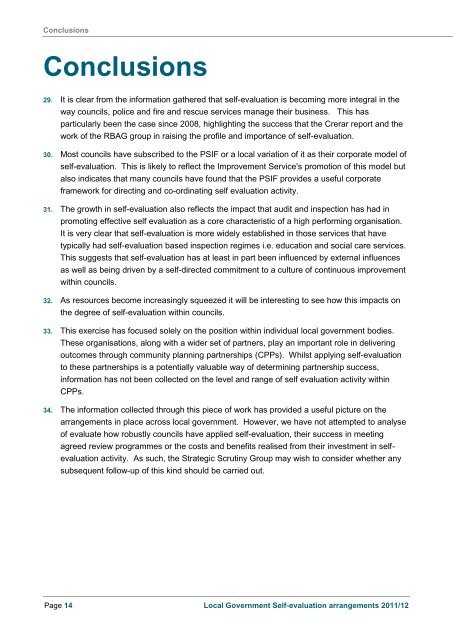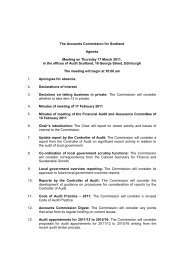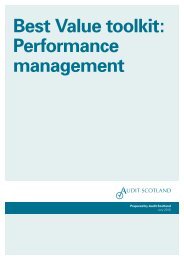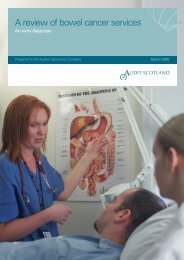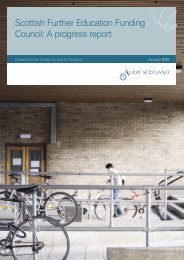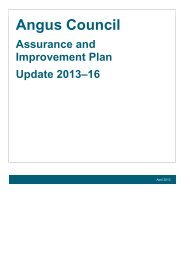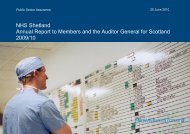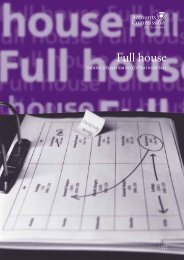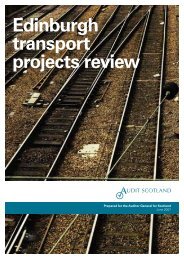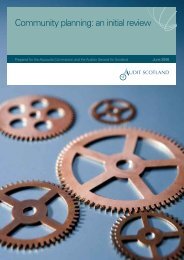Local Government self-evaluation arrangements ... - Audit Scotland
Local Government self-evaluation arrangements ... - Audit Scotland
Local Government self-evaluation arrangements ... - Audit Scotland
You also want an ePaper? Increase the reach of your titles
YUMPU automatically turns print PDFs into web optimized ePapers that Google loves.
ConclusionsConclusions29. It is clear from the information gathered that <strong>self</strong>-<strong>evaluation</strong> is becoming more integral in theway councils, police and fire and rescue services manage their business. This hasparticularly been the case since 2008, highlighting the success that the Crerar report and thework of the RBAG group in raising the profile and importance of <strong>self</strong>-<strong>evaluation</strong>.30. Most councils have subscribed to the PSIF or a local variation of it as their corporate model of<strong>self</strong>-<strong>evaluation</strong>. This is likely to reflect the Improvement Service's promotion of this model butalso indicates that many councils have found that the PSIF provides a useful corporateframework for directing and co-ordinating <strong>self</strong> <strong>evaluation</strong> activity.31. The growth in <strong>self</strong>-<strong>evaluation</strong> also reflects the impact that audit and inspection has had inpromoting effective <strong>self</strong> <strong>evaluation</strong> as a core characteristic of a high performing organisation.It is very clear that <strong>self</strong>-<strong>evaluation</strong> is more widely established in those services that havetypically had <strong>self</strong>-<strong>evaluation</strong> based inspection regimes i.e. education and social care services.This suggests that <strong>self</strong>-<strong>evaluation</strong> has at least in part been influenced by external influencesas well as being driven by a <strong>self</strong>-directed commitment to a culture of continuous improvementwithin councils.32. As resources become increasingly squeezed it will be interesting to see how this impacts onthe degree of <strong>self</strong>-<strong>evaluation</strong> within councils.33. This exercise has focused solely on the position within individual local government bodies.These organisations, along with a wider set of partners, play an important role in deliveringoutcomes through community planning partnerships (CPPs). Whilst applying <strong>self</strong>-<strong>evaluation</strong>to these partnerships is a potentially valuable way of determining partnership success,information has not been collected on the level and range of <strong>self</strong> <strong>evaluation</strong> activity withinCPPs.34. The information collected through this piece of work has provided a useful picture on the<strong>arrangements</strong> in place across local government. However, we have not attempted to analyseof evaluate how robustly councils have applied <strong>self</strong>-<strong>evaluation</strong>, their success in meetingagreed review programmes or the costs and benefits realised from their investment in <strong>self</strong><strong>evaluation</strong>activity. As such, the Strategic Scrutiny Group may wish to consider whether anysubsequent follow-up of this kind should be carried out.Page 14 <strong>Local</strong> <strong>Government</strong> Self-<strong>evaluation</strong> <strong>arrangements</strong> 2011/12


